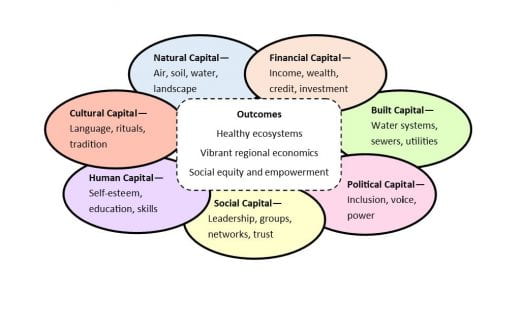 Community Capitals Framework; Measuring Success Now And In The Future
Community Capitals Framework; Measuring Success Now And In The Future
A common chord that communities all over the United States share is they are actively looking to the future. Whether it is a mid-level urban setting, or the smallest of “Small Town, USA,” leaders are trying to determine what the next steps are for their neighborhoods, counties or districts. The Community Capitals Series introduces the concept of measuring current successes and resources in communities based on seven dimensions called community capitals. According to Cheryl Jacobs, Community Leadership Development Extension Associate with South Dakota State University Cooperative Extension Service, capital is defined as a resource that is capable of producing additional resources. Community capitals are also a useful way of identifying potential improvements. In this article, we will be focusing on natural capital, which is defined as the environment, natural beauty, lakes, rivers and streams, forests, wildlife, soil and the local landscape.
Natural capital consists of all the natural resources available to a community, which could include water, air, fertile soil, biodiversity and landscape or wildlife habitats. These are all resources that are not man-made and already exist. Most all our natural capitals can be affected by things that are out of human control, such as drought.
Let’s look at an example of natural capital such as water. If your community has a river this could positively affect your natural capital with the financial impact that it could create due to tourism and recreation. In addition to financial capital, a river could also increase the quality of life for families who enjoy spending time outdoors, which could be considered social capital. From this example, it is easy to see how the capital framework is intertwined.
When thinking about the natural capital that exists in your community, you must first consider who owns it or who has rights to it. For instance, land usage could be the jurisdiction of local, state or federal entities. Regulations and ordinances are often in place and must be studied before a community can move forward with a project.
What kind of natural capital exists in your community? What are the benefits and what are the potential concerns? These are questions that communities need to consider as they plan for their future, understanding that there is an interconnection between each of the capitals.
K-State Research and Extension offers programs such as Kansas PRIDE, First Impressions, Disaster Education and Grant Writing that would be useful in assisting your community determine your natural capital and how to benefit from it.
The Wild West Extension Office has locations in Hugoton, Liberal and Sublette. If you have questions about this or any other Extension topic, please contact us. Also, find us on Facebook @wildwestdistrict or on the web at www.wildwest.ksu.edu.
| Wild West District
Stevens Co. Office 114 E. 5th St. Hugoton, KS 67951 620-544-4359 |
Wild West District
Seward Co. Office 1081 Stadium Road Liberal, KS 67901 620-624-5604 |
Wild West District
Haskell Co. Office PO Box 503 Sublette, KS 67877 620-675-2261 |
